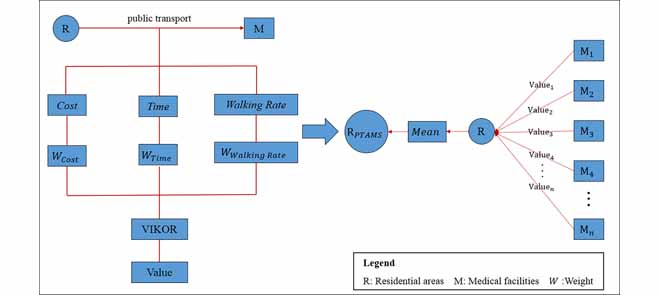篇名:Urban Public Transport Accessibility to Medical Services from the Perspective of Residents' Travel: A Hybrid Assessment Based on the Whole Process
作者:Xin Fu, Yongjie Qiang*, Xiaoxuan Zhao, Chengyao Xu, Feng-Jang Hwang,Chi-Hua Chen(陈志华)
来源:IEEE Access
年份:2021
DOI: 10.1109/ACCESS.2021.3049814
文章摘要:
Equitable access to efficient medical services via public transport has always been one of the most important issues of healthcare in urban development. To accurately measure the urban public transport accessibility to medical services (PTAMS), this research proposes a hybrid assessment method based on multiple public-transport related indicators, including time, cost, and walking rate, which considers the whole process of residents' public transport travel. The presented assessment technique is then applied in a case of Xi'an, China. Through the classification of medical facilities and PTAMS levels, the results show that: (a) PTAMS value of 3,080 residential areas in Xi'an are highly consistent with the standard normal distribution; (b) More than 80% of residential areas can obtain high PTAMS when considering the use of Class 1 (large-scale) hospitals, while the high PTAMS of Class 2 (small-scale) ones can only cover less than 40% residential areas; (c) There is obvious spatial heterogeneity in the distribution of PTAMS in Class 2 hospitals and a serious lack of medical equity; (d) Among large hospitals, the private ones retain higher PTAMS and equitability, making themselves best choice for residents, which is opposed to the government's purpose of establishing public hospitals; (e) PTAMS of most residents substantially dropped about 4% during the morning peak-hour. However, subway protects PTAMS of nearby residents. This research provides references and suggestions on how to improve residents' PTAMS under the existing public transport network and medical facilities layout.
通过公共交通公平获得高效医疗服务一直是城市发展中最重要的卫生保健问题之一。为了准确测量城市公共交通医疗服务可达性(PTAM),本研究提出了一种基于多个公共交通相关指标(包括时间、成本和步行率)的混合评估方法,该方法考虑了居民公共交通出行的全过程。然后将所提出的评估技术应用于中国西安的一个案例。通过对医疗设施和PTAMS水平的分类,结果表明:(1)西安市3080个居民点PTAMS值高度符合标准正态分布(b) 考虑使用一级(大型)医院时,80%以上的居民区可以获得高PTAM,而二级(小型)医院的高PTAM只能覆盖不到40%的居民区(c) 二级医院PTAM分布存在明显的空间异质性,医疗公平性严重缺失(d) 在大型医院中,私立医院保持较高的PTAM和公平性,成为居民的最佳选择,这与政府建立公立医院的目的背道而驰(e) 大部分居民的PTAM在早上高峰时段大幅下降约4%。然而,地铁保护附近居民的PTAM。本研究为在现有公共交通网络和医疗设施布局下如何改善居民PTAM提供参考和建议。
